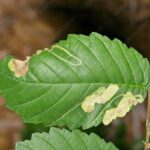Elm Leafminer
Leafminers & Needleminers
The Elm Leafminer (Fenusa ulmi) is a species of sawfly that is native to Europe and Asia, but has now spread to North America. It is an invasive species that attacks the leaves of elm trees, causing extensive damage. The Elm Leafminer is a small insect, with a body length of 4-7mm. It is greenish-yellow in color with a black head and thorax.
The female Elm Leafminer lays her eggs on the undersides of elm leaves in the spring. When the eggs hatch, the larvae feed on the mesophyll layer of the leaves, which causes yellowing and browning of the leaf. As the larvae mature, they tunnel further into the leaves, causing them to curl and become deformed. The larvae feed for about three weeks before pupating, and then emerging as adult insects.
The damage caused by the Elm Leafminer can weaken the tree, making it more susceptible to disease and other pests. In severe infestations, the damage can cause defoliation and can even kill small trees. Additionally, the larvae produce a sticky substance that can attract ants and other insects to the tree, further compounding the problem.
There are several methods of controlling Elm Leafminers. Cultural control methods include pruning out infested leaves and removing the larvae by hand. Chemical control methods include the use of insecticides, although these can be harmful to non-target species. There are also biological control methods, such as the release of parasitoid wasps that feed on the Elm Leafminer larvae.
In conclusion, the Elm Leafminer is a serious pest that can cause extensive damage to elm trees. Proper management is essential to prevent significant harm to these important trees, and to protect the health of our urban forests.



